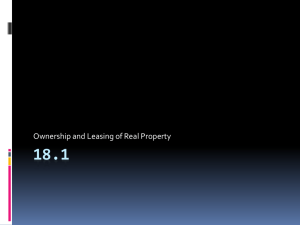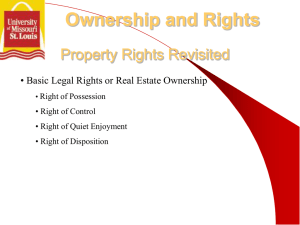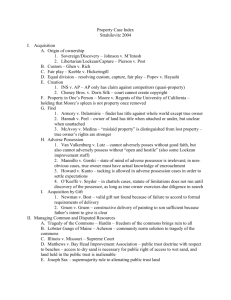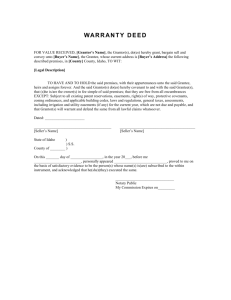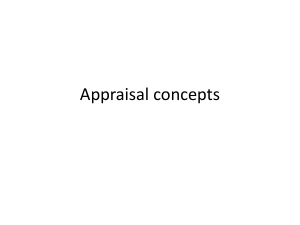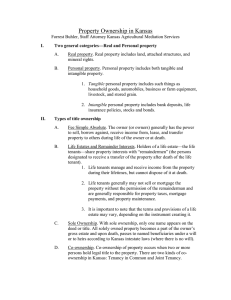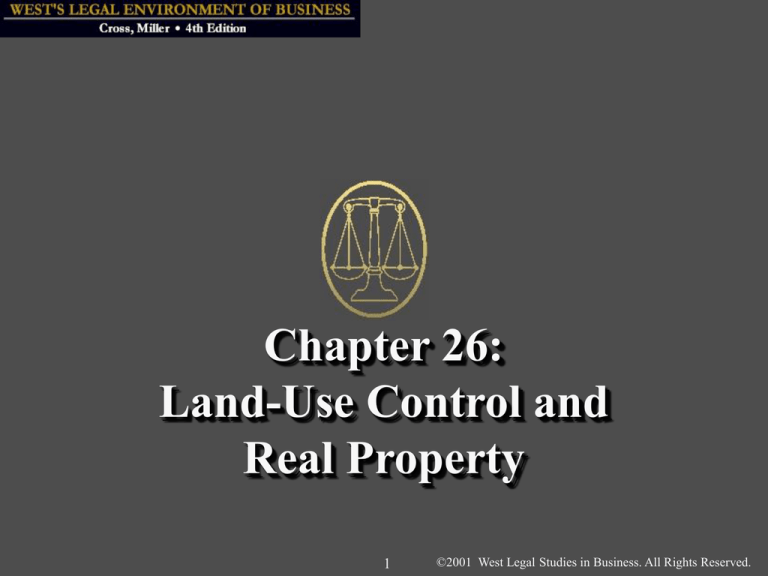
Chapter 26:
Land-Use Control and
Real Property
1
©2001 West Legal Studies in Business. All Rights Reserved.
Introduction
• Property ownership confers certain rights
that give the owner the right to possess,
control or transfer the property.
• Property is divided into real and personal
property. Real property includes land and
everything permanently attached to it.
Personal property is both moveable and
tangible or intangible (stocks, copyrights).
2
©2001 West Legal Studies in Business. All Rights Reserved.
§ 1: Nature of Real Property
• Real property is immovable and includes:
–
–
–
–
–
–
Land.
Buildings.
Trees and vegetation.
Airspace.
Subsurface (mineral) rights.
Fixtures.
3
©2001 West Legal Studies in Business. All Rights Reserved.
Land
• Land includes:
– Soil.
– Natural or man-made products attached to the
surface.
– Water and minerals under the surface.
– Airspace above the surface.
4
©2001 West Legal Studies in Business. All Rights Reserved.
Air Space and
Subsurface Rights
• Owner of real property has relatively
exclusive rights to:
– Air Space above the land; and
– Minerals and Soil beneath the land.
• Ownership of sub-surface rights can be
transferred or retained by the owner.
• Ownership of airspace very limited due to
federal preemption.
5
©2001 West Legal Studies in Business. All Rights Reserved.
Fixtures
• A fixture is personal property that becomes
permanently affixed to real property:
– Owner’s intent to become a fixture is necessary.
– Intent is determined by:
» The fact that the property cannot be removed
without causing damage to the realty.
» The fact that the property is so adapted to the realty
that it has become part of the realty.
– Case 26.1: New England Telephone &
Telegraph v. City of Franklin (1996).
6
©2001 West Legal Studies in Business. All Rights Reserved.
Fixtures [2]
• Trade fixtures: installed for commercial
purposes by a tenant.
• They remain the property of the tenant and
can be removed when tenant leaves,
repairing any damage caused by removal.
7
©2001 West Legal Studies in Business. All Rights Reserved.
§ 2: Ownership Interests in
Real Property
• Property ownership is viewed as a “bundle
of rights” that may include the:
–
–
–
–
–
Right to possess;
Right to sell;
Right to give;
Right to lease; and
Right to destroy.
8
©2001 West Legal Studies in Business. All Rights Reserved.
Fee Simple (Absolute)
• The fee simple (sometimes called fee
simple absolute) gives the owner the
greatest aggregation of rights, powers and
privileges possible under American law and
can assigned to the owner’s heirs.
• A “conveyance” (transfer of real estate)
“from A to B” creates a fee simple. A is the
Grantor and B is the Grantee.
9
©2001 West Legal Studies in Business. All Rights Reserved.
Fee Simple Defeasible
• Fee simple defeasible ownership contains a
condition. Example: “To A and his heirs so
long as the land is used for charitable
purposes.” If the condition is violated, the
land “reverts” or returns to the Grantor or
her heirs.
10
©2001 West Legal Studies in Business. All Rights Reserved.
Life Estates
• Estate that lasts for the life of some specified
individual. “A grants Blackacre to B for B’s life”
grants B a life estate in Blackacre.
• When B dies, Blackacre reverts to A or his heirs in
the same condition, normal wear and tear
excepted. During B’s life, she can possess, use,
and take the fruits of the estate, but not take from
the property itself.
• Case 26.2: Meadows v. Belknap (1997).
11
©2001 West Legal Studies in Business. All Rights Reserved.
Future Interests
• Reversionary Interest: Grantor retains right to repossess land when Grantee violates a condition
of a fee simple defeasible or the Grantee’s life
estate expires.
Reversionary Interest
Grantor
FSD or Life Estate
12
Grantee
©2001 West Legal Studies in Business. All Rights Reserved.
Future Interests [2]
Remainder Interest: Grantor assigns,
transfers or sells her future interest to a 3rd
Party who now has a remainder. When
condition is violated or Grantee dies, interest
passes to 3rd Party.
Grantor
FSD or Life Estate
Grantee
3P
13
©2001 West Legal Studies in Business. All Rights Reserved.
Leasehold Estates
• A real property owner or lessor agrees to
convey the right to possess and use the
property to a lessee for a certain period of
time:
–
–
–
–
Tenancy for Years.
Periodic Tenancy.
Tenancy at Will.
Tenancy at Sufferance.
14
©2001 West Legal Studies in Business. All Rights Reserved.
Concurrent Ownership
•Tenancy in common
(Fig.1). A and B own an
undivided interest in the
property. Upon B’s death
interest passes to B’s
heir, “C”.
•Joint Tenancy (Fig. 2). A
and B own an undivided
interest in property but,
upon B’s death, B’s
interest passes to A, the
surviving joint tenant.
15
A
Fig.1
B
C
Fig. 2
A
B
©2001 West Legal Studies in Business. All Rights Reserved.
Concurrent Ownership [2]
• Tenancy by the Entirety (not common today
is usually between husband and wife.
• Community Property (limited # of states).
– Property acquired by couple during their
marriage is owned as an undivided ½ interest in
property (real and personal).
16
©2001 West Legal Studies in Business. All Rights Reserved.
§3: Private Control
of Land Use
• An easement is a right of a person to make
limited use of another person's real property
without taking anything from the property.
• A profit is the right of way to go onto
another’s real property and take something
away (timber, minerals).
17
©2001 West Legal Studies in Business. All Rights Reserved.
Creation of an
Easement or Profit
• Easements or profits can be created by:
– Deed or Will.
– Implication: circumstances imply the creation
of an easement.
– Necessity.
– Prescription: created when use occurs during a
statutory period of time without landowner’s
consent.
18
©2001 West Legal Studies in Business. All Rights Reserved.
Termination of an
Easement or Profit
• By deed back to owner of the land burdened
by it.
• Owner of easement or profit becomes
owner of the land burdened with it.
• Abandonment by the owner of the right.
• Case 26.3: Preseault v. United States
(1996).
19
©2001 West Legal Studies in Business. All Rights Reserved.
Licenses
• Revocable right of a person to come unto
another’s land without removing anything
from the land.
• Personal privilege that arises from the
consent of the owner of the land that can be
revoked.
20
©2001 West Legal Studies in Business. All Rights Reserved.
Restrictive Covenants
• Private restriction on the use of land is
called a restrictive covenant.
• If the restriction is binding on future
purchasers and their heirs, it is said to “run
with the land.”
21
©2001 West Legal Studies in Business. All Rights Reserved.
Covenants Running
with The Land
• A restrictive covenant running with the land (CRWTL)
cannot be separated from the land.
• Four requirements must be met:
–
–
–
–
CRWTL must be written.
Parties must intend covenant to run with the land.
Covenant must touch and concern the land’s use.
Successors must have notice.
• Restrictive Covenants promoting segregation are
illegal.
22
©2001 West Legal Studies in Business. All Rights Reserved.
§ 4: Public Control of Land Use
• Rights in property are not absolute. They
are constrained by federal and state laws,
e.g., nuisance, tax and environmental laws.
• The federal government does not engage in
direct control of land, unless it is “federally
owned land.
• States can regulate land use and
development using their police and eminent
domain powers.
23
©2001 West Legal Studies in Business. All Rights Reserved.
Police Powers
• A State can regulate the use of land within
its borders using its police powers with
enabling legislation which authorizes a city
or county to regulate the use of land within
its geographical borders.
• Cities and counties regulate land-use in the
land-permitting process, but they must have
a “general plan” to implement zoning
restrictions for the management of private
and commercial development.
24
©2001 West Legal Studies in Business. All Rights Reserved.
Zoning
• Zoning is the State’s power to control the
use of land through legislation without
having to compensate the owner, unless the
restriction is so severe that it is a “taking”
under the 5th amendment.
• The zoning ordinance must be rational in
advancing a state interest and must be nondiscriminatory.
25
©2001 West Legal Studies in Business. All Rights Reserved.
Use Restrictions
• Land with “use restrictions” can be zoned
for residential, commercial, industrial or
agricultural use.
• Commercial districts are further zoned for
light or heavy use.
26
©2001 West Legal Studies in Business. All Rights Reserved.
Structural Restrictions
• Land zoned with “structural restrictions”
controls details such as minimum floor
space, lot-size, building height and parking.
• In addition, “set back” restrictions dictate
the distance between a building and a street
or sidewalk.
27
©2001 West Legal Studies in Business. All Rights Reserved.
Variances
• A zoning variance allows property to be used in a
way that varies from the zoning restriction. To
secure a variance:
– An owner must not be able to realize a reasonable return
on the investment;
– An owner must have been individually hurt by zoning
ordinance;
– The variance must not substantially alter the surrounding
area.
• Case 26.4: Allegheny West Civil Council v. Zoning
Board of Adjustment of Pittsburgh (1997).
28
©2001 West Legal Studies in Business. All Rights Reserved.
Limitations on Police Powers
• The government’s police powers are limited
by the 14th and 5th amendments to the
United States Constitution.
• The 14th amendment requires that any
regulation of land must not violate either the
due process of equal protection provisions.
– Due Process requires any regulation to have a
rational basis reasonably related to health or
general welfare.
29
©2001 West Legal Studies in Business. All Rights Reserved.
Limitations on Police Powers [2]
• The 14th amendment’s equal protection
clause prohibits discriminatory land use
regulations.
– A zoning ordinance cannot treat different land
owners differently unless there is a rational
basis for a legitimate health, safety or general
welfare concerns.
– Case 26.5: Shemo v. Mayfield Heights (2000).
30
©2001 West Legal Studies in Business. All Rights Reserved.
Limitations on Police Powers [3]
• Under the 5th amendment, private property may
not be “taken” for “public use” without “just
compensation.”
• Government regulations of private property that
deny an owner the ability to use or develop the
land for any reasonable income-producing venture
results in a “taking” of the land that requires
payment.
• Case 26.6: Purdie v. Attorney General (1999).
31
©2001 West Legal Studies in Business. All Rights Reserved.
Eminent Domain
• Government has an inherent power to take
property for public use without the consent of the
owner.
• Every landowner owns her land subject to a
superior right of the state to “condemn” the land
and pay fair value, which is usually equally to fair
market value.
• Case 26.7: City of Branson v. Estate of LaFavre
(2000).
32
©2001 West Legal Studies in Business. All Rights Reserved.
Law on the Web
• Housing and Urban Development.
• Information on the Buying and Selling of
Homes.
• Legal Research Exercises on the Web
33
©2001 West Legal Studies in Business. All Rights Reserved.


